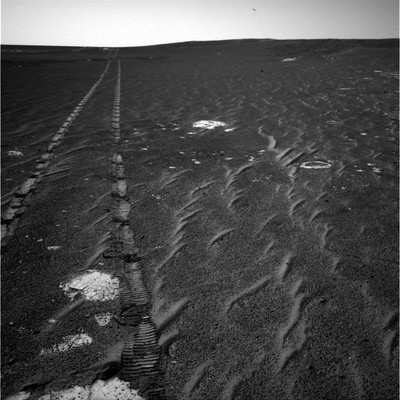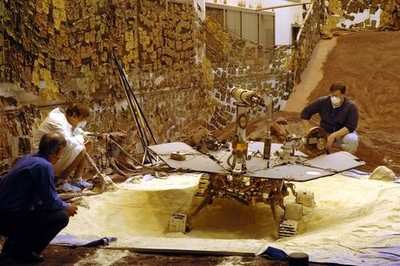Tue, May 19, 2009
NASA's rover project team is using the Spirit rover and other
spacecraft at Mars to begin developing the best maneuvers for
extracting Spirit from the soft Martian ground where it has become
embedded.

A diagnostic test on May 16 provided favorable indications about
Spirit's left middle wheel. The possibility of the wheel being
jammed was one factor in the rover team's May 7 decision to
temporarily suspend driving Spirit after that wheel stalled and
other wheels had dug themselves about hub-deep into the soil. The
test over the weekend showed electrical resistance in the left
middle wheel is within the expected range for a motor that has not
failed.

"This is not a full exoneration of the wheel, but it is
encouraging," said John Callas of NASA's Jet Propulsion Laboratory,
Pasadena, Calif., project manager for Spirit and its twin rover,
Opportunity. "We're taking incremental steps. Next, we'll command
that wheel to rotate a degree or two. The other wheels will be kept
motionless, so this is not expected to alter the position of the
vehicle."
Another reason to suspend driving is the possibility that the
wheels' digging into the soil may have lowered the body of the
rover enough for its belly pan to be in contact with a small mound
of rocks. The rover team is using Opportunity to test a procedure
for possible use by Spirit: looking underneath the rover with the
microscopic imager camera that is mounted on the end of the rover's
arm. This might be a way to see whether Spirit is, in fact,
touching the rocks beneath it.

NASA's Mars Odyssey orbiter is also aiding in the Spirit
recovery plan. As a result of winds blowing dust off Spirit's solar
panel four times in the past month, Spirit now has enough power to
add an extra communication session each day. The Odyssey project
has made the orbiter available for receiving extra transmissions
from Spirit. The transmissions include imaging data from Spirit's
examinations of soil properties and ground geometry.

Rover team members are using that data and other information to
construct a simulation of Spirit's situation in a rover testing
facility at JPL. The team is testing different materials to use as
soil that will mimic the physical properties of the Martian soil
where Spirit is embedded. Later, the team will test maneuvers to
get the rover free. Weeks of testing are anticipated before any
attempt to move Spirit.
More News
Light Gun A handheld directional light signaling device which emits a brilliant narrow beam of white, green, or red light as selected by the tower controller. The color and type of>[...]
"The journey to this achievement started nearly a decade ago when a freshly commissioned Gentry, driven by a fascination with new technologies and a desire to contribute significan>[...]
Aero Linx: JAARS, Inc. For decades now, we’ve landed planes on narrow rivers and towering mountains. We’ve outfitted boats and vehicles to reach villages that rarely se>[...]
"Our driven and innovative team of military and civilian Airmen delivers combat power daily, ensuring our nation is ready today and tomorrow." Source: General Duke Richardson, AFMC>[...]
Aircraft Conflict Predicted conflict, within EDST of two aircraft, or between aircraft and airspace. A Red alert is used for conflicts when the predicted minimum separation is 5 na>[...]
 ANN's Daily Aero-Term (04.20.24): Light Gun
ANN's Daily Aero-Term (04.20.24): Light Gun Aero-News: Quote of the Day (04.20.24)
Aero-News: Quote of the Day (04.20.24) ANN's Daily Aero-Linx (04.21.24)
ANN's Daily Aero-Linx (04.21.24) Aero-News: Quote of the Day (04.21.24)
Aero-News: Quote of the Day (04.21.24) ANN's Daily Aero-Term (04.21.24): Aircraft Conflict
ANN's Daily Aero-Term (04.21.24): Aircraft Conflict





